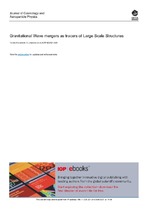| dc.contributor.author | Karagiannis, D | |
| dc.contributor.author | Libanore, S | |
| dc.contributor.author | Artale, M.C | |
| dc.date.accessioned | 2021-06-03T10:11:00Z | |
| dc.date.available | 2021-06-03T10:11:00Z | |
| dc.date.issued | 2021 | |
| dc.identifier.citation | Karagiannis, D. et al. (2021). Gravitational wave mergers as tracers of large scale structures. Journal of Cosmology and Astroparticle Physics,2021(2),035 | en_US |
| dc.identifier.issn | 14757516 | |
| dc.identifier.uri | 10.1088/1475-7516/2021/02/035 | |
| dc.identifier.uri | http://hdl.handle.net/10566/6253 | |
| dc.description.abstract | Clustering measurements of Gravitational Wave (GW) mergers in Luminosity Distance Space can be used in the future as a powerful tool for Cosmology. We consider tomographic measurements of the Angular Power Spectrum of mergers both in an Einstein Telescope-like detector network and in some more advanced scenarios (more sources, better distance measurements, better sky localization). We produce Fisher forecasts for both cosmological (matter and dark energy) and merger bias parameters. Our fiducial model for the number distribution and bias of GW events is based on results from hydrodynamical simulations. The cosmological parameter forecasts with Einstein Telescope are less powerful than those achievable in the near future via galaxy clustering observations with, e.g., Euclid. However, in the more advanced scenarios we see significant improvements. Moreover, we show that bias can be detected at high statistical significance. Regardless of the specific constraining power of different experiments, many aspects make this type of analysis interesting anyway. | en_US |
| dc.language.iso | en | en_US |
| dc.publisher | IOP Publishing Ltd | en_US |
| dc.subject | Cosmological parameters from LSS | en_US |
| dc.subject | Gravitational waves/experiments | en_US |
| dc.subject | Power spectrum | en_US |
| dc.subject | Redshift surveys | en_US |
| dc.title | Gravitational wave mergers as tracers of large scale structures | en_US |
| dc.type | Article | en_US |

